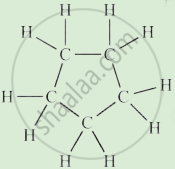Advertisements
Advertisements
Question
The molecules having triple bond in them are:
(a) oxygen and ethyne
(b) carbon dioxide and ammonia
(c) methane and ethene
(d) nitrogen and ethyne
Solution
(d) nitrogen and ethyne
In a nitrogen molecule, each nitrogen atom shares its 3 electrons to form a triple bond among them. In an ethyne molecule, each carbon atom shares 3 electrons to form a triple bond among them.
APPEARS IN
RELATED QUESTIONS
What would be the electron-dot structure of carbon dioxide which has the formula CO2?
Fill in the following blank with suitable word:
The form of carbon which is known as black lead is ...........
State any two uses of graphite.
What are the conditions necessary for the formation of covalent molecules?
Match the pairs.
| Group 'A' | Group 'B' |
| a. C2H6 | 1. Unsaturated hydrocarbon |
| b. C2H2 | 2. Molecular formula of an alcohol |
| c. CH4O | 3. Saturated hydrocarbon |
| d. C3H6 | 4. Triple bond |
Draw all possible structural formulae of compound from their molecular formula given below.
C3H8
Explain the following term with example.
Unsaturated hydrocarbon
Give examples for the following:
Two solid covalent compounds.
Explain the following:
Covalent compounds are generally gases or liquids or soft solids.
Name a neutral covalent molecule which contains one lone pair of electrons.
An element L consists of molecules.
What type of bonding is present in the particles that make up L?
State the type of bonding in the following molecule.
Water
Compound X consists of molecules.
Choose the letter corresponding to the correct answer from the options A, B, C and D given below:
The type of bonding in X will be ______.
Taking MgCl2 as an electrovalent compound, CCl4 as a covalent compound, give four difference between electrovalent and covalent compounds
Name gas with rotten egg smell.
Name the anion present in the following compound:
When a barium chloride solution is added to a solution of compound B, a white precipitate insoluble in dilute hydrochloric acid is formed.
Name the types of Hydrocarbons.
Complete the following activity.
Write the names of the hydrocarbons for the following structural formula.
(isobutylene, cyclohexane, propene, cyclohexene, cyclopentane, benzene, propyne, isobutane, propane)
 |
Identify the incorrect statement and correct them.
- Like covalent compounds, coordinate compounds also contain charged particles (ions). So they are good conductors of electricity.
- Ionic bond is a weak bond when compared to Hydrogen bond.
- Ionic or electrovalent bonds are formed by mutual sharing of electrons between atoms.
- Loss of electrons is called Oxidation and gain of electron is called Reduction.
- The electrons which are not involved in bonding are called valence electrons.
In covalent bond formation, the sharing of ______ electrons takes place in their outermost shell.
